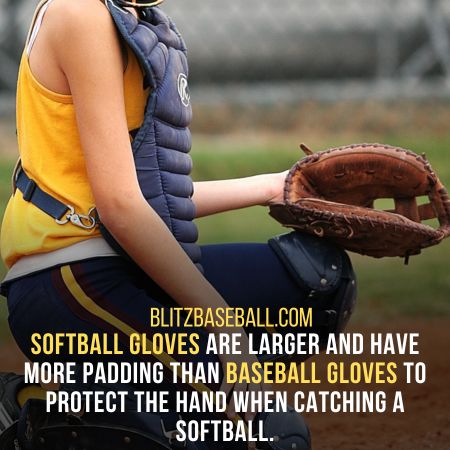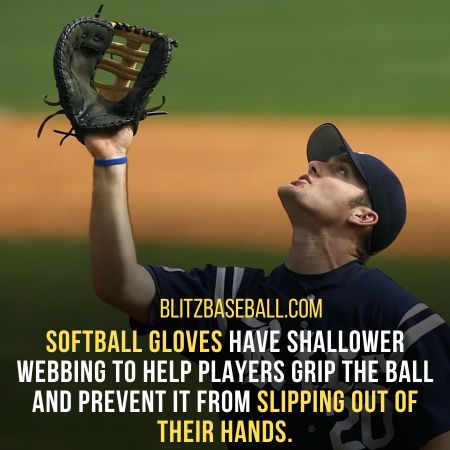Softball glove vs baseball glove are distinct in their design and functionality. This article aims to provide an ultimate comparison guide between these two types of gloves.
The differences encompass size, padding, webbing, material, and position-specific designs. Softball gloves are typically larger than baseball gloves, with more padding to safeguard the hand during catching. The deeper pockets in softball gloves aid in catching the ball effectively.
In contrast, baseball gloves possess webbing between the thumb and first finger, enabling flexion and closure around the ball. Additionally, softball gloves are predominantly yellow, while baseball gloves commonly feature white coloration. The palms and fingers of baseball gloves are typically tanned and treated leather.
Furthermore, position-specific gloves exhibit variations in size and padding, with catchers and first basemen gloves being larger and providing additional cushioning. Sizing and measurement of gloves are determined by the distance from the top of the index finger to the heel, with variations based on age and fielding position.
Moreover, softball gloves have further distinctions, including different sizes for age groups and fielding positions, diverse webbing designs, and variations in padding and wrist adjustment based on position.
The choice and breaking-in process of a glove are crucial for optimal performance.
Key Takeaways
- Softball gloves are larger and have more padding than baseball gloves to protect the hand when catching a softball.
- Softball gloves have shallower webbing to help players grip the ball and prevent it from slipping out of their hands.
- Baseball gloves have tanned and treated leather palms and fingers, while softball gloves are typically yellow.
- Different fielding positions in both softball and baseball require specific glove sizes, designs, and padding.
Size and Padding Differences: Softball glove vs baseball glove
Softball gloves are larger than baseball gloves and have more padding to provide additional hand protection when catching a softball, as well as deeper pockets to facilitate easier ball retrieval. The larger size of softball gloves allows players to have a greater catching surface, increasing the chances of successfully catching the ball.
The added padding in softball gloves helps absorb the impact of catching a softball, which is larger and softer than a baseball. This padding is crucial in preventing hand injuries and reducing the risk of stinging sensations. However, the larger size and added padding of softball gloves may also result in reduced flexibility and maneuverability compared to baseball gloves.
Players who prioritize mobility and quick ball transfers may prefer the smaller and less padded design of baseball gloves. Therefore, the size and padding differences between softball gloves and baseball gloves have both pros and cons that players should consider based on their specific needs and preferences.
Webbing Differences
The webbing on a baseball glove is designed to flex and close around the ball, providing a secure grip. The importance of webbing design in glove performance cannot be overstated. The webbing acts as a crucial element in catching and securing the ball during gameplay.
It allows players to make quick and accurate catches, preventing the ball from slipping out of their hands.
The shallow webbing in softball gloves, on the other hand, has both pros and cons. The shallowness of the webbing helps players grip the ball tightly, reducing the chances of it slipping out.

However, it may also make it slightly more challenging to catch certain types of balls, such as line drives or hard-hit balls. Players need to adapt their catching techniques accordingly to maximize the benefits of shallow webbing.
Material and Color Differences
Leather is commonly used for the palms and fingers of baseball gloves. Baseball gloves typically have tanned and treated leather palms and fingers, which provide durability and a traditional feel.
The leather used in baseball gloves can vary in quality, with top-quality gloves featuring high-grade leather that is more durable and requires less maintenance.
Softball gloves often feature synthetic materials. Softball gloves often utilize synthetic materials such as synthetic leather or synthetic fabrics.
These materials offer increased flexibility and a lighter weight, making them suitable for the fast-paced nature of softball. While synthetic materials may not have the same longevity as leather, they are generally easier to maintain and can withstand the rigors of softball gameplay.
Position-Specific Gloves
Catchers mitts and first basemans mitts are larger and have extra padding, while infielders gloves and pitchers gloves are smaller and have less padding. Outfielders gloves are larger and also have extra padding for added protection.
When it comes to position-specific gloves in baseball and softball, there are distinct differences to accommodate the unique demands of each position. Here are the key variations:
Catchers vs. First basemans gloves:
- Catchers mitts are designed with a larger size and extra padding to withstand the impact of fast pitches and protect the catcher’s hand.
- First basemans mitts are also larger and have extra padding, but they feature extended finger pockets to provide better scooping and catching ability.
Infielders vs. Outfielders gloves:
- Infielders gloves are smaller in size with less padding to allow for quick ball transfers and better control during fielding plays.
- Outfielders gloves are larger with extra padding to provide added protection when making diving catches or reaching for high-flying balls.
These distinctions in size and padding ensure that players have the appropriate equipment for their specific positions, allowing them to excel in their roles on the field.
Sizing and Measurement
Position-specific gloves in baseball and softball come in various sizes to ensure a proper fit for players based on their hand measurements. The right glove size is crucial for optimal performance and comfort on the field.
To determine the correct size, players can refer to a glove size chart that provides guidelines based on age and fielding position. Measuring techniques involve measuring from the top of the index finger to the heel of the glove.
Gloves size range from extra small (6 inches or less) to extra extra large (10.5 to 11 inches). Achieving the right fit is essential for players to have full control and flexibility when fielding or catching the ball. By using a glove size chart and accurate measuring techniques, players can select a glove that fits them perfectly, enhancing their overall performance.
| Glove Size | Measurement (in inches) |
|---|---|
| Extra Small | 6 or less |
| Small | 6 – 6.75 |
| Medium | 6.75 – 7.5 |
| Large | 7.5 – 8 |
| Extra Large | 8 – 10.5 |
| Extra Extra Large | 10.5 – 11 |

Frequently Asked Questions
What is the difference in weight between a softball glove and a baseball glove?
The weight of a softball glove and a baseball glove can vary depending on factors such as size, padding, and materials used. Generally, softball gloves tend to be slightly heavier than baseball gloves due to their larger size and additional padding for catching softballs.
Can a baseball glove be used for both slow pitch and fast pitch softball?
No, a baseball glove cannot be used for both slow pitch and fast pitch softball. Slow pitch and fast pitch softball have specific glove requirements, including different glove weights, glove color regulations, and specific glove designs for catchers mitts and youth players. It is recommended that players use the appropriate glove size for their position in either slow pitch or fast pitch softball.
Are there any specific rules or regulations regarding the color of softball gloves?
Rules and regulations on the color of softball gloves may vary depending on the league or organization. However, there are no specific universally enforced rules on the color of softball gloves. When considering glove material, leather gloves offer durability and a traditional feel, while synthetic gloves are often more affordable and easier to break in. The choice between leather and synthetic gloves for softball ultimately depends on personal preference and budget.
How do catchers mitts in baseball differ from catchers mitts in softball?
The comparison of pocket depth in catchers mitts in baseball and softball reveals that softball catchers mitts typically have deeper pockets than baseball catchers mitts. This allows for better ball control and grip. However, using a softball catchers mitt in baseball may present challenges due to the larger size and different ball characteristics.
Is there a recommended glove size for youth players in both softball and baseball?
When choosing the right glove size for young players in both softball and baseball, it is recommended to consider their age, position, and hand size. Properly fitting gloves ensure comfort, protection, and optimal performance on the field.

Conclusion
In conclusion, softball gloves and baseball gloves have distinct differences in size, padding, webbing, material, and position-specific designs.
Softball gloves are larger and have more padding to protect the hand when catching a softball, while baseball gloves have tanned and treated leather palms and fingers.
The webbing on softball gloves is shallower compared to baseball gloves, and softball gloves are typically yellow while baseball gloves are usually white.
Position-specific gloves vary in size and padding, and sizing and measurement are done from the top of the index finger to the heel.
Selecting and breaking in a glove is crucial for optimal performance in both sports.
